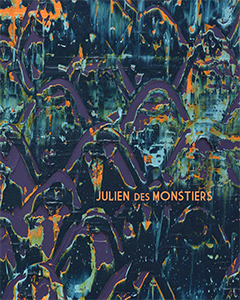First monograph: focusing on French painter's Julien des Monstiers most recent work, this publication features a rich iconography with reproductions and exhibition views. An introductory text by
Frédéric Valabrègue invites us into the artist's studio, and the interview by Alain Berland gives a formidable insight into des Monstiers' practice.
To take it all. Not leave anything out. To renew one's spontaneity in the scope of pictural possibilities: classicism,
expressionism,
figurative,
abstract, print painting, bad painting, all-over, matterism. To Julien des Monstiers, each painting constitutes a whole, the different styles of which can be understood in their entirety, that ultimately gives them meaning. A holistic painting that cannot be reduced to the sum of its parts and that eludes any pre-established definition. From borrowed shapes and gestures, with no hierarchy, to the medium's great stories: from Diego Velasquez to Jean-Baptiste Oudry, from
Robert Rauschenberg to
Gerhard Richter, from
Lucio Fontana to
Sigmar Polke, but also to the history of its motifs, that of hunting scenes, floral decors or tapestry. A work painted on canvas or on wood, on the floor or on a wall, depending on its needs, in a constant back-and-forth motion. Imprints by transfer, as he has always done but also precise gestures, slow or swift, made with brushes of course, but also other miscellaneous tools like sticks and even, why not, if he feels like it, marbles. Everything is grasp-worthy for an artist who considers the chassis as a frame on which to build his own territory, made of borrowings and inventions.
Paintings made with ever-thwarted layers, strata so closely overlapping they cannot be differentiated. A “non-style”, filled with overload, colored dissonances, and impasto that paradoxically becomes “a style”. Ill-assorted sometimes, for the viewer and perhaps even for its author, for it is filled with ambiguous sensations, feelings that go from rejection to felicity. A body of work with no concern whatsoever for seriality, a most beloved component nowadays, in the art world and more specifically its market, as it allows for an immediate identification. A painting that isn't an open window on the world, but rather many doors that lead to the spaces where the creation matter lies. Maybe that of the ever-so-distant yet ever-so-close primitive caves, the artist so often calls upon. Magical places where our ancestors composed with projections and hollows in the rock, but also with their environment, moving lights, accidents and missed tra jectories.
Published on the occasion of the exhibition “Maison, Sarcophage, Allumettes”, galerie Christophe Gaillard, Paris, from September 8 to October 13, 2018.











